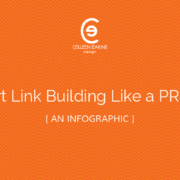Have Fun with this Social Media Marketing Challenge
So, you are excited about the benefits that social media marketing offers your business. Now you’re looking to launch a winning campaign that will help people find your brand. Great. The only thing left to do is to create compelling content that will attract shares and likes. Luckily for you, fantastic content doesn’t take long to construct.
Let’s take a look at a stress-free plan to create two weeks’ worth of lovable sharing ideas to help attract your ideal clientele. This strategy combines using common sense and a small bit of digital effort to help convey your brand message to an online audience.
#1 | Show People Who You Are and How You Work
People love images, especially ones that show people engaged in work that stokes their passions. That means coming up with the perfect share could be as simple as snapping a pic at work. Plainly you see pictures like this all the time, and there’s a logical explanation for that. Consumers need to trust your organization, and one way to help them do that is by showing them who you are and what you do on a daily basis.
#2 | Put a Customer or Vendor in the Spotlight
Interview a vendor or one of your customers to gain their insight and to share online. Adding a fresh, secondary perspective makes your content even more accessible. Communication with key personalities in your brand’s value chain will open doors. A loyal customer will probably love appearing on your profiles and will know that you value their opinion. Vendors bring industry-specific expertise to bear that enhance your corporate image.
#3 | Answer a Pressing Question
Fielding questions and relating comprehensive answers is another beneficial way to spread the word about your business. Potential clients want to know they’re dealing with an expert or experienced professional. Rather than tell them how amazing you are, why not show them instead? You can write a blog post or make a video on Facebook or Instagram that covers a common question for your industry. People who are searching for new vendors will often have these sorts of queries in mind, so you get a chance to introduce yourself to them quickly.
#4 | Introduce New Workers
Do you have any new employees? If so, now would be an ideal time to share the news. A smiling face could help start a conversation on the social networks that assist you in beginning a business relationship. Never forget that it’s always about people, so projecting a warm, friendly persona goes a long way towards brand acceptance.
#5 | Add Your Take to a Trending Topic
Now and then a trending, non-controversial topic will closely relate to your industry or you personally. When it does, share the issue with your audience and add relevant commentary. Since the subject is fresh in people’s minds, your post will get more attention, which also draws eyes towards your brand.
#6 | Tickle Their Funny Bones
Believe it or not, funny cat images are still incredibly powerful! Occasionally sharing pictures or videos that you find amusing is a quick way to gain popularity.
#7 | Fill-In-The-Blanks Are Fun and Engaging
Making a Fill-In-The-Blank is a fun way to engage your digital audience. Any topic can work, but you may as well relate it to your industry and organization for maximum impact.
#8 | Tell the World Your Story
Tell your brand’s story whenever possible, in the most natural way possible. Explain how your company operates and detail your mission. Help others to become passionate about dealing with your company because they share your values.
#9 | Inspire Your Audience
Who doesn’t benefit from reading or hearing something inspirational? Depending on the nature of your business or organization, this could include progress reports on current projects, charitable work you’re involved in, or looking back on how far you’ve come.
#10 | Broadcast Live Video
Are you hosting an event or just having an awesome day at work? Consider doing a Live Video broadcast on Facebook or other Platforms to connect with your audience with the power of video. Ideas could include product demonstrations, client interviews, or broadcasting your event.
#11 | Recognize Another Business
As they say, ‘sharing is caring!’ If you stop by a local company or business, consider sharing a picture is a great way to recognize other companies and share the love!
#12 | Share an Interesting Fact
Almost everyone will agree that it’s refreshing to learn little-known facts. Infographics are particularly compelling for sharing statistics and other structured data.
#13 | Repurpose Like A Boss
Don’t overlook the body of work you already have at your fingertips. Instead of creating something entirely new from scratch, use a photo or other digital asset differently. (Think image filters, text, etc.)
#14 | Celebrate The Season
Join the crowd and help your followers celebrate the season – whatever the season may be! Commonly celebrated Spring holidays include Valentine’s Day, St. Patrick’s Day, and Easter. Summer holidays include Memorial Day, July 4th, and Labor Day. Autumn holidays include Halloween and Thanksgiving, followed by Christmas when winter arrives.
#15 | Share Your Newsletter Content in Your Social Circles
The chances are good that not everyone you interact with online gets your email newsletter. These days, most commercial email providers make it easy for you to share your email newsletter to your social media platforms. This feature empowers you to offer your friends and fans access to your newsletters from their favorite platform.
#16 | Do a Poll to Increase Engagement
One of the most fun ways to engage with your fans, and followers is by making a poll. People love to give their opinions and feedback, so this is an ideal way to energize and promote interactions with your audience.
#17 | Join New Platforms and Establish Your Online Presence
These days, there is always a new online platform to explore and establish your online presence. Embrace the opportunity to join and use these platforms to connect with people you may not know!
We hope that you find this post helpful for spicing things up on your social media marketing channels for the next two weeks!

I’m a Digital Marketer & Freelance Writer with a penchant for all things forward-thinking and positive. I’m a fan of abundance and progress.


 ©2018, Colleen Eakins Design
©2018, Colleen Eakins Design


